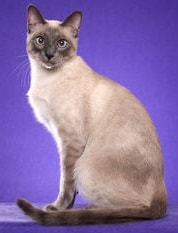Type the name of the breed you're looking for below
[wpdreams_ajaxsearchlite] Don't see the breed your're looking for? Click here and let us know!
Breed Characteristics
1 paw - breed exhibits the least amount of this characteristic
5 paws - breed exhibits most amount of this characteristic
Thai
| Origin And History | For at least 700 years, the Thai people have cherished a pointed breed called the Wichienmaat. From Thailand's famous Cat Poems (Tamra Maew), we know Thais bred the Wichienmaat in the Thai kingdom of Ayudhia, continued to breed them as Ayudhia was succeeded by the kingdom of Siam, and still breed them today in modern Thailand. In the 19th century, British citizens discovered the Wichienmaat, an extraordinary blue-eyed cat with a whitish body and dark points, in Thailand (then called Siam). They found them nowhere else in the world, and decided to import the cats, calling them "Siamese." The goal of the Western breeders was to improve the natural pointed breed of Siam, making it more consistent and more striking in appearance. They soon produced cats with much deeper blue eyes than those in the breed's native country. They also bred for an increasingly stylized head and body. By the 1950s, some Siamese cats in the show ring had much longer heads, finer boning, and slimmer bodies than those at the turn of the century. Many people loved the improvements in the Siamese, but others preferred the older, more moderate look of the breed. The Thai began to diverge from the Siamese breed in the 1950s, when breeders around the world chose to breed Siamese of the moderate, early 20th century type. By the 1980s, moderate type Siamese were no longer competitive at shows, as mainstream breeders were breeding a much more extreme cat. In the 1980s, the first breed clubs dedicated to the old-style Siamese appeared in Europe and North America. In 1990, in Europe, the World Cat Federation granted the breed championship status and changed the name to Thai differentiate the old type of Siamese from the show-style Siamese. In 2001, breeders began importing indigenous pointed cats from Thailand to preserve a healthy gene pool for the Thai breed and to preserve the genes of Southeast Asia's native race of cats while they are still distinct from Western cats. In 2007, TICA granted Preliminary New Breed status to the Thai, and in 2009 promoted the Thai to Advanced New Breed, making it possible for breeders in North America and Europe to work together and show together under a single breed standard. |
| Personality | The Thai has the personality made famous the world over by the early Siamese. They are highly intelligent, people-loving, active, curious, and endowed with a great sense of humor. Living with these cats is like living with small children. They will get into everything you own, jump to the top of your wall-mounted clock and balance there, teetering, just to see if they can. They will follow you around and try to "help" you with everything you are doing. Thais are great talkers. They aren't necessarily loud, but they're chatty. They will greet you at the door when you come home and start chatting away. They also communicate with taps of the paw or by jumping to the top of your shoulder and putting their face right in yours. They will need a response and daily attention from you. Without it, they will suffer, and suffering, they will act out. Physically, these cats are easy to maintain-self-cleaning, no grooming needed. But emotionally, they are high maintenance. For those who want a close companion, this is your breed. They will get to know you, and you them. It's a friendship that will deepen with the years-like fine wine. |
Physical Attributes
| Appearance | The key to distinguishing the Thai from other shorthaired, pointed breeds is in the details of head shape and body style. The Thai is a shorthaired, pointed cat of foreign type. It's moderately long and substantial, supple and lithe, but in no way extreme. The boning is medium-tail, legs, head, all medium-boned. Coming from tropical Thailand, the breed has a short, flat coat. It's loose enough to feel soft and silky, but still quite short. It's not tight and slick like glass, nor does it feel plush. But the trademark of the Thai breed is the unique head shape. The forehead is long and flat. There is good width to the head, and its sides are rounded. From that round-cheeked head projects a distinctly wedge-shaped muzzle. At the cheekbones, there's a slight curve inward to where the muzzle begins. Then, the muzzle tapers gradually toward the nose. The end of the muzzle is somewhat spade-shaped, not pointy but not blunt. The ears are broad-based and set relatively high on the head, somewhat like fingers in a "peace sign." |
| Health | The Thai cats can be prone to developing cross-eyes and kinked tails, but these are merely physical problems that has no impact on their longevity. Otherwise, the breed is naturally healthy. |



